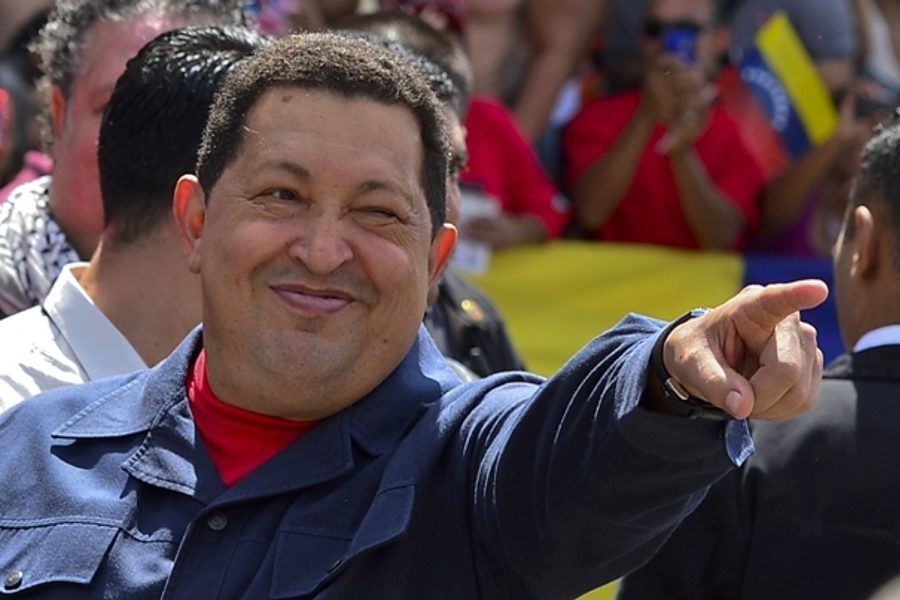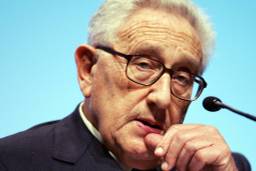
On Sunday, Hugo Chávez won a fourth term as Venezuela’s president, beating out opposition candidate Henrique Capriles with 54.42 percent of the vote. Coverage in the Western media of the election was absurdly one-sided, with Chávez portrayed as a thug running a quasi-dictatorship, his electoral support bought directly with oil money. But coverage on the Left has been simplistic in another way, with many taking at face value the president’s claims about constructing a “socialism of the 21st century.”
This piece is an attempt to explain Chavismo as a new form of populism. Fundamentally, Chávez’s reelection was a victory for progressive forces in his country and one that should be celebrated. But the processes unfolding in Venezuela are complicated: The Bolivarian Revolution is both authoritarian and democratic, demagogic and participatory.
Before Hugo Chávez, no one was expecting a socialist renaissance in Venezuela, a nation with rosy relations with the United States and a prosperous middle class. His 1998 election appeared to be nothing more than a parliamentary victory for a bombastic social democrat, surprising but hardly epochal. During his campaign, Chávez stood for a reorientation of state oil company Petróleos de Venezuela (PDVSA) towards social development, a “third way” alternative to neoliberalism, an increased minimum wage, constitutional reform and a clampdown on government corruption. A discontented electorate warmly received the outsider’s rhetoric, giving him 56.4 percent of the popular vote.
“Watch what Chávez does, not what he says,” was the U.S. State Department’s line upon his election, implying that his politically expedient wealth redistribution pledges were soon to collide with reality. A decade and change later we can note the lack of foresight — Chavez has went far beyond his initial promises — but the Left could still benefit from Washington’s advice.
Following what Chávez says means taking a meander across the political spectrum. He summons Keynes with reverence, but he’s not a Keynesian. His style evokes Perón, but he’s not another Caudillo. He makes outbursts against materialism and globalization, but the ex-military officer would stick out on the G20 protest circuit. Chávez’s background is marked by a disconnect from the organized working class and the historic institutions of the Venezuelan Left. It’s fitting then that bits and pieces of everyone from Bolivar to Keynes to Che flow from his largely improvised communiqués.
Simply, Chávez is a populist in the Latin America tradition, but one distinctly more radical — if less predictable — than those who came before him.
Classical Populism
Populism is a vague, slippery concept. Its definition and utility have long been contested among academics, more often than not the term carrying with it pejorative connotations. The simplest way to view populism is as a rhetorical style, one that divides society into two contending groups — “the people” and “the elite.” This implies the creation of new political subjects, but also the merging of old class identities. There is no room for a working class with interests sometimes counterpoised to those of the “lumpenproletarian,” the petty proprietor or the peasant — they are all “the people.” The differentiation between intellectuals, certain capitalists and the old landed elite is similarly subsumed under the umbrella of “the oligarchy.”
The populist leadership style has proved especially successful in Latin America, finding its archetype in the mid-20th century presidency of Juan Perón. A colorful campaigner, Perón gained the loyalty of both a newly urbanized working class and a nascent industrial bourgeoisie. The former military officer’s charismatic leadership proved enough to foster a shaky compromise between the two rising social classes. Workers submitted to a Faustian bargain, their unions recognized and labors rewarded with higher wages and more responsive social services, but their struggles co-opted and institutionalized.
Argentina’s “infamous decade” was followed by Perón’s presidency. Perón’s policies stood on a radical “center,” between both socialism and traditional liberal capitalism. They were analogous, in some respects, to the social democratic policies that flourished in postwar Europe. Like those regimes, Perón’s relied on a historic class compromise. The support of newly urbanized workers gave classical populists a proletarian veneer, but Perón also drew support from middle-class elements who sympathized with redistribution and benefited from state-sponsored economic programs. Even certain segments of the elite were in league with populists: The co-opting of portions of the labor movement into populist parties created a climate where an uneasy “pro-industrial” alliance between workers and industrial capitalists could prevail. The charismatic glue of the populist leader was enough to bottle up the class contradictions of such an arrangement.
Rhetorical appeals to the descamisados (Perón’s impoverished, working class supporters) aside, Perón, like others in the populist orbit, never encouraged class struggle or attempted to structurally undermine the bourgeois state. It was his recognition of friendly unions and the material rewards of economic prosperity during the early years of his presidency that crowded out support for left-wing challengers. For the first time, as well, the state began to recognize and enforce labor laws. Unions and Perón relied on each other for legitimization.
After being swept from power in the 1950s, Perón made an improbable political comeback. But on his 1973 return, the president openly supported his party’s right-wing. But his moment was over. The iconic leader died just months into his third term. The classical populist moment was over, as well. The economic policy of import substitution on which it was based confronted a structural crisis, leaving the path open for neoliberalism. The populist style, however, remained and adapted itself to the new situation.
Neo-populism
Neo-populism emerged as a political force in the 1990s and was not limited to Latin America — Peru’s Fujimori and Argentina’s Menem are listed along with Berlusconi and Perot by theorists of the phenomenon. Neo-populism borrowed the rhetorical style of classical populism and married it to the politics of neoliberal austerity.
Yet neo-populists did not initiate the neoliberal project; in fact, they emerged out of conditions created by globalization and liberalization. With the collapse of the global “center” and the breakdown of its institutions — the welfare state, for one — a political vacuum emerged. Membership in trade unions dropped and the working class adapted itself to new forms of employment in a service and export-based economy. The stability afforded by state-subsidized industry was dismantled, leaving workers atomized and in an unprecedented state of flux. Without the old institutions of working class representation — the trade union and its favored political party — many voters became apathetic or embraced the “politics of anti-politics.” Some old industrial capitalists also suffered as their businesses were put to the mercy of the world market for the first time in a generation. And yet at the same time, the power of “more dynamic” forms of capital in the service and finance sectors grew.
“Neo-populism” can only be understood as emerging out of this political environment. With industrial capital and organized labor too weak to maintain the classical populist arrangement, the politics of macro-redistribution lost their social base. But the rhetoric of populism had a lasting appeal thanks to the positive connotations of Peronism. The new content of populism would represent a more sustainable class arrangement, a new alliance between finance capital, middle class professionals and segments of the “underclass.”
Micro-redistribution, through the lending of small loans and the creation of a more market-responsive safety net, was not merely tacked onto austerity and restructuring programs for political reasons, they represented a distinctly neoliberal worldview that promoted “meritocracy” and equalized opportunities over cruder forms of egalitarianism.
“Meritocracy,” a lofty sounding concept, makes a virtue out of inequality, legitimizing the class system by propagating a fantasy in which people aren’t held back by structural inequality and hierarchy, but by themselves. Which is to imply that the solutions to social problems require individual self-help rather than collective political action. In other words: Put down The Manifesto, pick up The Secret. Without the social actors capable of pushing an alternative agenda, neo-populism and other like-minded ideologies (“Third Way” social democracy in the West, for example) represented the furthest limits of politics in an apolitical age — the style and rhetoric of past “political-eras” masking the triumph of neoliberalism.
In the same way that the past crisis of the agro-export model of growth led to the institutionalization of import substitution industrialization, the crisis of import substitution in the 1970s provoked a new socio-economic order (neoliberalism), along with new forms of political participation (neo-populism, among them). This articulation occurred through populist rather than class politics, because of both the setbacks of the global Left during this period and the diminished social base for such politics. Even in countries that maintained some class politics — like Brazil and its Workers’ Party — parties had to adapt their social base and economic programs to the new reality.
Radical Populism
Latin American politics over the past decade have been dominated by a new breed of populism, more radical and confrontational in nature. It is a project riddled with irony and contradiction; at once a reaction against the volatility brought upon by neoliberalism — including the deterioration of the social safety net and of many traditional organs of popular expression — and the very same “decaying and corrupt” liberal institutions that once helped facilitate popular expression and macro-redistribution.
Radical populists are no longer tied to industrial capital in the way that the classical populists were. They too adopt a Manichean discourse, but marry this radical discourse with genuine attempts to alter the state through the creation of “popular power” to complement the power of the executive branch. Rather than facilitate an alliance between the working class and capital, radical populists like Chávez have at times encouraged class conflict and wildcat occupations, something well outside the ambit of Peronist politics.
But that Chávez seemingly emerged out of nowhere and not on the back of a labor or social movement — unlike Lula in Brazil or Morales in Bolivia — is not surprising given the historical context. By the 1980s, the Venezuela Left was, along with its labor movement, in terminal crisis.
In the 1950s, Venezuelan “official Communists” threw their lot in with social democrats against the military dictatorship. But when democracy finally came to the country, Acción Democrática turned to their right, announcing the Punto Fijo Pact, essentially establishing a two-party system that would dominate the country’s politics for decades. The pact edged the Communist Party completely out of the mainstream.
At the same time, the Cuban example enlivened the imagination of frustrated activists within the party. Instead of slowly building support among urban workers, many of the youngest and most energetic radicals took to the hills to engage in Guevarist guerrilla warfare. Their struggle would prove futile and counterproductive. Revolutionaries lost whatever mass support they may have had and the party’s mainstream once again faced state repression.
In this climate of defeat, a young officer in the 1980s, Chávez had aligned himself with a small group of left-nationalist soldiers. Under Chávez’s leadership, the group organized itself as the Movimiento Bolivariano Revolucionario. Then lieutenant and fellow conspirator Francisco Arias recalls that the group “agreed that there was a need for an organization that could stimulate the process of structural change.”
Chávez entered the Venezuelan consciousness after his group launched an unsuccessful 1992 coup d’état. Chávez intended to use the military as a vehicle of progressive change, a shortcut to impose reforms from above. Such messianic politics and ad-hoc substitution for the working class fits within the continuum of Venezuelan radicalism.
If anything the discontinuity between Chávez and the 20th century revolutionary project has been an advantage for the president. He may have failed tactically on the battlefield, but the defiant officer won the media war. As a condition of his surrender, Chávez gave an impassioned address to the Venezuelan public, remarking that the rebels had failed in their objectives “por ahora” … for now.
With the state’s legitimacy in free-fall following the Caracazo — a wave of protests and riots against President Carlos Andrés Pérez’s neoliberal austerity program — Chávez was heralded in many quarters as a national hero. After a two-year prison sentence, he was pardoned in 1994. Chávez and his supporters quickly built up a national network to contest in the 1998 presidential election. Chavez’s Movimiento Quinta República attracted the support of the poor and middle class, as well as those who supported him as a protest against the country’s corrupt and complacent two-party system.
Chávez’s upset victory did not turn Venezuela on its head right away. In fact, as commentators like Francisco Rodriguez have noted, though the President presented his reforms as a major departure from the “Washington Consensus” that was then hegemonic in the region, the pace of change was moderate at first. But in a neat parallel to the opposition to Perón, it only took the perception of dramatic change to rouse the ire of reaction.
A coup d’état on April 11, 2002, appeared to spell the end of the Chávez moment. The hubris of the reactionaries was astounding, and mainstream Venezuelan media outlets, complicit to varying degrees, at the very least could not hide their delight. Pedro Carmona, president of the Venezuelan Federation of Chambers of Commerce, was installed as interim president, and the National Assembly, Supreme Court and 1999 Constitution were dissolved to rousing applause. The United States and Spain rushed to establish relations with the new government. The event, framed in Orwellian terms by much of the Latin American Right, was a “triumph for democracy.”
But the opposition underestimated the support Chávez still had among the Venezuelan poor. A spontaneous mass uprising by hundreds of thousands of people outside the Miraflores Palace and the revolt of Chavista officers within turned the table on the plotters. Within 47 hours the government was restored, but extra-parliamentary resistance to the regime continued.
There was another challenge almost immediately after, however. Adopting the slogan “2002 without Christmas, 2003 without Chávez,” a general strike began on December 2. The state-run oil company PDVSA, many of whose employees belonged to the anti-Chavista labor union Confederación de Trabajadores de Venezuela (CTV), was a focal point of the resistance. The early momentum of the actions petered out and in the end only strengthened and radicalized the Bolivarian movement. The government fired 19,000 employees at PDVSA and resumed production with a friendly new managerial core. The transformed company administered a large part of the government’s new social initiatives, called “missions.” Following a 2004 recall referendum victory, Chávez radicalized his rhetoric and declared at a World Social Forum speech the following year his intention to construct a “socialism of the 21st century.”
The move to the Left has only continued since then, with the growth of a mass socialist party, experiments in participatory democracy and a growing welfare state, Chávez has attempted to use Venezuela’s vast oil wealth to benefit its people.
Yet some of the criticism Chávez has received is justified. Venezuela’s soaring crime rate and deplorable prison conditions are impossible to ignore. It is also undeniable that facing hostility in the media and an entrenched elite, the president has at times used executive power to circumvent political opposition.
The experiments in participatory democracy have also left a mixed record. Out of the more than 220,000 registered cooperatives, only 70,000 are active — a failure rate of 70 percent. The ones that have survived, far from serving as vehicles of worker empowerment, have in some respects institutionalized underground-economy work without improving conditions. Since they are supposedly equal “partners” in a firm, groups of cooperative members who feel exploited within their workplace cannot engage in industrial action. This status as “self-employed associates” rather than “workers” also means they are exempt from national labor laws governing basic protections such as minimum wage requirements. These features are attractive to large capitalist firms that outsource work to cooperatives — many of them staffed by unemployed ex-union members — in order to minimize their reliance on combative permanent workers.
But the relationship between Chávez and his supporters is complex and dialectical. Even though — through an influx of state credit, training programs and moral exhortations — the cooperative project has been initiated from the top-down, the momentum pushing the wider Bolivarian movement has come from struggles from below. Political activity that had reached a nadir before Chávez’s election has been revived under his presidency.
This is an important difference between the classical and radical populist eras. Juan Perón and his cohorts co-opted a rising Left. Chávez has seemingly resurrected one and has at times struggled to keep up with the forces he helped unleash. The Bolivarian Circles represent with exquisite precision the ethos of the Revolution: These community councils were organized in an attempt to bury the state deep into civil society, to bypass potentially hostile local elected officials and to dole out patronage directly from the center. But they are, as Nikolas Kozloff puts it, at once “anti-democratic, creating a kind of vertical dependency around the cult figure of Chávez” and simultaneously creating a real terrain of democratic deliberation.
Acknowledging this paradox is key to a sober understanding of Chavismo and its contradictions. The haphazard way in which it has developed and its mix of failure and success is just history — messy, as always.
Bhaskar Sunkara is the president of The Nation magazine and the founding editor of Jacobin. Follow him on Twitter: @sunraysunray.







